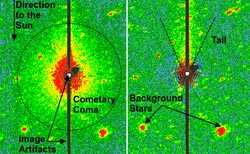NAU-led team discovers comet hiding in plain sight

Don Quixote’s coma and tail (left) as seen in infrared light by NASA’s Spitzer Space Telescope. After image processing (right), the tail is more apparent. Image courtesy NASA/JPL-Caltech/DLR/NAU<br>
The discovery resulted from an ongoing project led by researchers at Northern Arizona University using the Spitzer Space Telescope. Through a lot of focused attention and a little bit of luck, they found evidence of cometary activity that had evaded detection for three decades.
“Its orbit resembled that of a comet, so people assumed it was a comet that had gotten rid of all its ice deposits,” said Michael Mommert, a post-doctoral researcher at NAU who was a Ph.D. student of professor Alan Harris at the German Aerospace Center (DLR) in Berlin at the time the work was carried out.
What Mommert and an international team of researchers discovered, though, was that Don Quixote was not actually a dead comet—one that had shed the carbon dioxide and water that give comets their spectacular tails.
Instead, the third-biggest near-Earth asteroid out there, skirting Earth with an erratic, extended orbit, is “sopping wet,” said NAU associate professor David Trilling. The implications have less to do with potential impact, which is extremely unlikely in this case, and more with “the origins of water on Earth,” Trilling said. Comets may be the source of at least some of it, and the amount on Don Quixote represents about 100 billion tons of water—roughly the same amount found in Lake Tahoe.
Mommert said it’s surprising that Don Quixote hasn’t been depleted of all of its water, especially since researchers assumed that it had done so thousands of years ago. But finding evidence of CO2, and presumably water, wasn’t easy.
During an observation of the object using Spitzer in August 2009, Mommert and Trilling found that it was far brighter than they expected. “The images were not as clean as we would like, so we set them aside,” Trilling said.
Much later, though, Mommert prompted a closer look, and partners at the Harvard-Smithsonian Center for Astrophysics found something unusual when comparing infrared images of the object: something, that is, where an asteroid should have shown nothing. The “extended emission,” Mommert said, indicated that Don Quixote had a coma—a comet’s visible atmosphere—and a faint tail.
Mommert said this discovery implies that carbon dioxide and water ice also might be present on other near-Earth objects.
This study confirmed Don Quixote’s size and the low, comet-like reflectivity of its surface. Mommert is presenting the research team’s findings this week at the European Planetary Space Conference in London.
Media Contact
More Information:
http://www.nau.eduAll latest news from the category: Physics and Astronomy
This area deals with the fundamental laws and building blocks of nature and how they interact, the properties and the behavior of matter, and research into space and time and their structures.
innovations-report provides in-depth reports and articles on subjects such as astrophysics, laser technologies, nuclear, quantum, particle and solid-state physics, nanotechnologies, planetary research and findings (Mars, Venus) and developments related to the Hubble Telescope.
Newest articles

Bringing bio-inspired robots to life
Nebraska researcher Eric Markvicka gets NSF CAREER Award to pursue manufacture of novel materials for soft robotics and stretchable electronics. Engineers are increasingly eager to develop robots that mimic the…

Bella moths use poison to attract mates
Scientists are closer to finding out how. Pyrrolizidine alkaloids are as bitter and toxic as they are hard to pronounce. They’re produced by several different types of plants and are…

AI tool creates ‘synthetic’ images of cells
…for enhanced microscopy analysis. Observing individual cells through microscopes can reveal a range of important cell biological phenomena that frequently play a role in human diseases, but the process of…





















